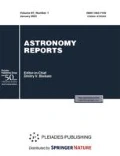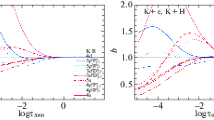Abstract
A mechanism for the segregation of calcium isotopes in the atmospheres of chemically peculiar (CP) stars due to light-induced drift (LID) of singly charged 48Ca+ ions is discussed. One peculiarity of Ca+ is that an adequate description of the effect of LID requires taking into account several energy levels of Ca+, and thus several pairs of relative differences (ν i − ν k )/ν i for the transport frequencies for collisions of levels i and k with neutral atoms (hydrogen, helium). The known real (calculated ab initio) interaction potentials are used to numerically calculate the factors (ν i − ν k )/ν i for several states of Ca+ for collisions with H and He atoms. These computations show that, at the temperatures characteristic of the atmospheres of CP stars, T = 6600−12 000 K, fairly high values are obtained for Ca+ ions, (ν i − ν k )/ν i ≈ 0.4−0.6. Simple, transparent computations demonstrate that the LID rates of Ca+ ions in the atmospheres of cool CP stars (Teff = 6600 K) exceed the drift rate due to light pressure by two orders of magnitude. The LID is directed upward in the stellar atmosphere, and the heavy isotope 48Ca is pushed into upper layers of the atmosphere. This can explain the observed predominance of the heavy isotope 48Ca in the upper atmospheric layers of CP stars; according to the radiative-diffusion theory, the action of light pressure alone (in the absence of LID) would lead to sinking of the isotope 48Ca deeper into stellar atmosphere, following the lighter main isotope 40Ca. The 48Ca+ LIDrate decreases and its drift rate due to light pressure increases with growth of the effective temperatures in the atmospheres of CP stars. The manifestations of LID and light pressure are roughly comparable in the atmospheres of CP stars with effective temperatures near Teff = 9500 K.
Similar content being viewed by others
References
G. W. Preston, Ann. Rev. Astron. Astrophys. 12, 257 (1974).
E. F. Borra, J. D. Landstreet, and L. Mestel, Ann. Rev. Astron. Astrophys. 20, 191 (1982).
V. L. Khokhlova, Itogi Nauki Tekh., Ser.: Astron. 24, 233 (1983).
G. Michaud, Astrophys. J. 160, 641 (1970).
G. Michaud, Y. Charland, S. Vauclair, and G. Vauclair, Astrophys. J. 120, 447 (1976).
G. Michaud, Astron. J. 85, 589 (1980).
G. Michaud, in IAU Symposium 224: The A-Star Puzzle, Ed. by J. Zverko, J. Ziznovsky, S. J. Adelman, and W. W. Weiss (Cambridge University Press, Cambridge, 2004), p.173.
G. Michaud, G. Alecian, and J. Richer, Atomic Diffusion in Stars (Springer Int., New York, London, Switzerland, 2015).
S. N. Atutov and A. M. Shalagin, Sov. Astron. Lett. 14, 284 (1988).
F. Kh. Gel’mukhanov and A. M. Shalagin, JETP Lett. 29, 711 (1979).
V. D. Antsygin, S. N. Atutov, F. Kh. Gel’mukhanov, G. G. Telegin, and A. M. Shalagin, JETP Lett. 30, 243 (1979).
K. A. Nasyrov and A. M. Shalagin, Astron. Astrophys. 268, 201 (1993)
F. LeBlanc and G. Michaud, Astrophys. J. 408, 251 (1993).
A. Aret and A. Sapar, Astron. Nachr. 323, 21 (2002).
A. Sapar, A. Aret, L. Sapar, and R. Poolamae, New Astron. Rev. 53, 240 (2009).
L. Sapar, A. Sapar, R. Poolamae, and A. Aret, Baltic Astron. 23, 171 (2014).
T. Ryabchikova, O. Kochukhov, and S. Bagnulo, Astron. Astrophys. 408, 811 (2008).
C. R. Cowley, S. Hubrig, and J. F. Gonzalez, Mon. Not. R. Astron. Soc. 396, 485 (2009).
A. I. Parkhomenko and A. M. Shalagin, Astron. Rep. 61, 974 (2017).
H. Habli, H. Ghalla, B. Oujia, and F. X. Gadea, Eur. Phys. J. D 64, 5 (2011).
N. F. Allard and V. A. Alekseev, Adv. Space Res. 54, 1248 (2014).
A. A. Radtsig and B. M. Smirnov, Reference Data on Atoms, Molecules, and Ions (Energoatomizdat, Moscow, 1986; Springer, Berlin, 1985).
NIST Atomic Spectra Database. https://www.nist.gov/pml/atomic-spectradatabase.
S. G. Rautian and A. M. Shalagin, Kinetic Problems of Nonlinear Spectroscopy (Elsevier, Amsterdam, New York, 1991).
D. Mihalas, Stellar Atmospheres (W. H. Freeman, San Francisco, 1978;Mir, Moscow, 1982).
F. K. Gel’mukhanov, L. V. Il’ichov, and A. M. Shalagin, Physica A 137, 502 (1986).
J. O. Hirschfelder, Ch. F. Curtiss, and R. B. Bird, Molecular Theory of Gases and Liquids (Wiley, New York, 1954).
J. H. Fertziger and G. Caper, Mathematical Theory of Transport Processes in Gases (North-Holland, Amsterdam, 1972; Mir, Moscow, 1976).
W. A. Hamel, J. E. M. Haverkort, H. G. C. Werij, and J. P. Woerdman, J. Phys. B 19, 4127 (1986).
V. Aquilanti and F. Vecchiocattivi, Chem. Phys. Lett. 156, 109 (1989).
V. M. Zhdanov, Transport Processes in Multicomponent Plasma (Energoizdat, Moscow, 1982; CRC, Boca Raton, FL, 2002).
S. Maleki and A. T. Goble, Phys. Rev. A 45, 524 (1992).
F. Gebert, Y. Wan, F. Wolf, C. N. Angstmann, J. C. Berengut, and P. O. Schmidt, Phys. Rev. Lett. 115, 053003 (2015).
W. Nörtershäuser, K. Blaum, K. Icker, P. Müller, A. Schmitt, K. Wendt, and B. Wiche, Eur. Phys. J. D 2, 33 (1998).
R. L. Kurucz, Astrophys. J. Suppl. Ser. 40, 1 (1979).
Y. Fremat, L. Houziaux, and Y. Andrillat, Mon. Not. R. Astron. Soc. 279, 25 (1996).
Author information
Authors and Affiliations
Corresponding author
Additional information
Original Russian Text © A.I. Parkhomenko, A.M. Shalagin, 2018, published in Astronomicheskii Zhurnal, 2018, Vol. 95, No. 6, pp. 407–420.
Rights and permissions
About this article
Cite this article
Parkhomenko, A.I., Shalagin, A.M. Segregation of Calcium Isotopes in the Atmospheres of CP Stars as a Consequence of Light-Induced Drift. Astron. Rep. 62, 383–395 (2018). https://doi.org/10.1134/S1063772918050050
Received:
Accepted:
Published:
Issue Date:
DOI: https://doi.org/10.1134/S1063772918050050




